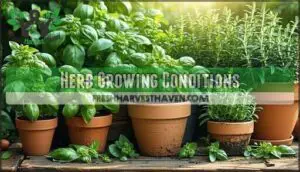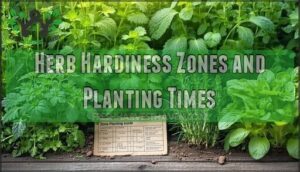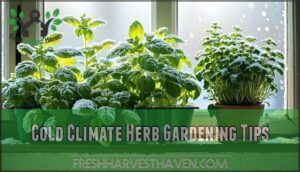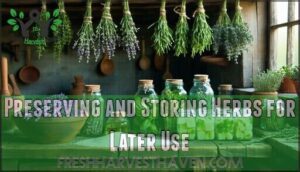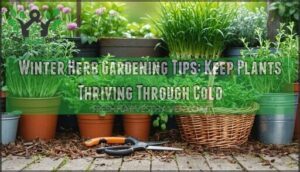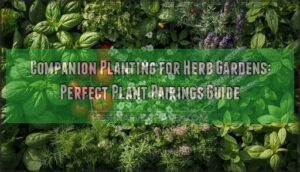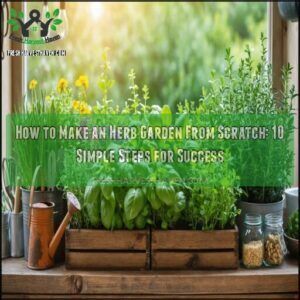This site is supported by our readers. We may earn a commission, at no cost to you, if you purchase through links.
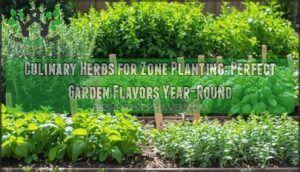 When planning culinary herbs for zone planting, you’ll want to match your herb selections to your hardiness zone for the best results.
When planning culinary herbs for zone planting, you’ll want to match your herb selections to your hardiness zone for the best results.
Hardy perennials like rosemary, oregano, sage, and thyme can overwinter in most zones, while tender annuals such as basil and lemongrass need protection from frost.
Consider your zone’s first and last frost dates when timing your plantings – cool-season herbs like cilantro thrive in early spring, while heat-loving basil waits until soil warms.
Your zone determines which herbs you can grow as perennials versus those you’ll treat as annuals, making smart variety choices essential for a thriving herb garden that delivers fresh flavors throughout the growing season.
Table Of Contents
- Key Takeaways
- Choosing Culinary Herbs
- Herb Growing Conditions
- Herb Care and Maintenance
- Zone Specific Herb Planting
- Culinary Herb Uses and Benefits
- Frequently Asked Questions (FAQs)
- What are the best culinary herbs to grow?
- Is culinary thyme a perennial?
- What is the mother of all herbs?
- What herbs cannot be planted next to each other?
- How to attract beneficial insects with herbs?
- What are common pests for culinary herbs?
- How to design a herb garden layout?
- What herbs can grow in hydroponic systems?
- Are there herbs safe for pets?
- What companion plants work best with herbs?
- Conclusion
Key Takeaways
- Match your herb selections to your specific hardiness zone – You’ll ensure survival by choosing hardy perennials like rosemary and thyme for cold climates, while treating tender herbs like basil as annuals in cooler zones.
- Time your plantings around frost dates – You’ll maximize success by planting cool-season herbs like cilantro in early spring and waiting until the soil warms for heat-loving basil.
- Provide proper growing conditions for each herb’s needs – You’ll create thriving plants by offering 6-8 hours of sunlight daily, well-draining soil with a pH of 6.0-7.0, and matching watering schedules to each herb’s requirements.
- Use zone-appropriate preservation and care techniques – You’ll extend your harvest by applying proper mulching for winter protection, regular pruning to encourage growth, and preserving herbs through drying or freezing methods.
Choosing Culinary Herbs
You’ll need to match your herb choices to your specific hardiness zone to guarantee they survive your local climate and growing conditions.
Start by identifying herbs that thrive in your zone’s temperature range, then consider their sunlight, soil, and water requirements to create a successful culinary garden.
Herb Characteristics and Uses
Anyone can create a thriving culinary herb garden by understanding each herb’s unique characteristics and uses.
Your culinary herb garden becomes a flavorful success story when you match varieties to your growing zone.
Basil offers sweet, peppery notes that complement tomatoes perfectly, while rosemary delivers robust, pine-like flavors ideal for hearty meats.
Thyme provides earthy undertones that enhance everything from soups to roasted vegetables.
Herb Flavor Profiles range from mint’s cooling freshness to oregano’s warm intensity.
Medicinal Herb Uses include peppermint for digestion and lavender for relaxation.
Aromatic Herb Uses extend beyond cooking—sage purifies air while cilantro adds bright, citrusy notes.
- Unique Herb Varieties like purple basil change tea colors when citrus is added
- Herb Culinary Pairings work best when you match Mediterranean herbs with olive oil dishes
- Flavor profiles develop differently based on harvesting time and growing conditions
Understanding these herb characteristics helps you select the perfect flavorful addition for your culinary herb garden.
Climate and Zone Considerations
Understanding your USDA hardiness zone transforms herb gardening from guesswork into success.
Microclimates around your home create warmer spots for tender culinary herbs like basil, while frost dates guide planting timing.
Regional variations and elevation effects influence herb hardiness zones, so research local conditions.
Match zone planting strategies to your climate for thriving herbs year-round.
Herb Growing Conditions
You’ll create the perfect growing environment for your culinary herbs by providing 6-8 hours of daily sunlight and well-draining soil with a pH between 6.0-7.0.
Success depends on matching your watering schedule to each herb’s needs and choosing the right containers for healthy root development, which is crucial for the herbs’ overall health and well-draining soil is essential.
Sunlight and Soil Requirements
Most culinary herbs thrive with consistent light exposure of 6-8 hours daily, making sunny locations essential for robust growth.
Your soil drainage needs are critical—waterlogged roots spell disaster for Mediterranean herbs like rosemary and thyme.
Aim for nutrient-rich soil with a soil pH between 6.0-7.0, using soil amendments like compost to boost nutrient levels and improve drainage naturally.
To guarantee healthy growth, regularly check your soil’s acidity.
Watering and Fertilization Needs
Successfully watering your culinary herbs requires understanding their specific needs.
Most herbs thrive when soil reaches a semi-dry state between waterings, preventing root rot while maintaining adequate moisture.
Watering Frequency varies by zone planting conditions, but these guidelines help:
- Check soil moisture by inserting your finger one inch deep
- Water deeply but less frequently to encourage strong root systems
Adjust Fertilizer Types based on container versus ground planting needs. Using the correct fertilizer is key, so consider herb fertilizer options carefully.
Container Gardening Tips
Three essential container gardening tips transform your herb garden into a thriving culinary powerhouse.
Start with well-draining potting mixes and containers featuring proper drainage holes—waterlogged roots spell disaster for most herbs.
Choose container sizes wisely: compact herbs like basil flourish in smaller pots, while chives need deeper space for their extensive root systems.
Vertical gardens maximize growing space, perfect for apartments or small patios.
Match your containers to your zone’s climate, and consider drip systems for efficient watering.
Herb Care and Maintenance
Your herbs need regular care to thrive throughout the growing season and survive harsh winters.
Proper pruning, protection, and propagation techniques guarantee healthy plants that’ll keep your kitchen stocked with fresh flavors year after year, ensuring proper care for your herbs.
Pruning and Pinching Techniques
Smart herb pruning transforms your culinary herb garden into a productive powerhouse. Regular trimming keeps plants bushy, delays flowering, and maximizes harvest potential across any herb gardening zone.
Shaping herbs requires the right approach and timing. Here’s your zone planting pruning playbook:
- Encourage bushiness by pinching basil stems just above leaf pairs
- Make precise cuts on woody herbs like rosemary using sharp pruning shears
- Tool selection matters – use clean, sharp scissors for delicate herbs
- Delay flowering by removing flower buds on cilantro and parsley regularly
Herb pruning becomes second nature once you understand each plant’s growth pattern. Regular pruning also helps prevent potential diseases.
Mulching and Winter Protection
When you’ve pruned your herbs properly, protecting them through winter becomes your next priority.
Mulch serves as nature’s blanket, providing essential soil insulation for your culinary herbs. Apply mulch types like straw, shredded leaves, or bark chips around cold hardy herbs in late fall.
This winter protection maintains consistent soil temperature and prevents freeze-thaw cycles that damage roots. Proper mulching guarantees optimal herb growth.
For zone planting success, match your frost protection strategy to your zone hardiness requirements—tender herbs need winter covers or indoor relocation.
Propagation Methods and Tips
Propagation naturally transforms one herb plant into many, expanding your garden without extra costs.
Master these proven techniques for herb multiplication:
- Cutting Propagation: Take 4-6 inch stem cuttings from healthy plants, dip in rooting hormones, then plant in moist potting mix.
- Seed Starting: Sow herb seeds in seed trays with quality potting soil, maintaining consistent moisture until germination occurs.
- Division Methods: Split established perennial herbs like chives or mint by carefully separating root systems during spring growth.
Zone Specific Herb Planting
Your hardiness zone determines which herbs will thrive in your garden and when you can plant them safely.
Understanding your zone’s frost dates and temperature ranges helps you choose the right herbs and plan your planting schedule for maximum success, considering your zone’s unique conditions to ensure maximum success.
Herb Hardiness Zones and Planting Times
Since your USDA hardiness zone determines which culinary herbs survive winter, check your zone planting guide for first frost dates and seasonal herb starts.
Microclimate effects like sheltered patios extend growing seasons beyond zone-specific guidelines.
Dill and cilantro prefer cooler weather, while rosemary thrives in warmth.
Indoor herb zones help dodge frost, enhancing your year-round growing herbs zone garden design.
Some herbs, like thyme, have woody stems year-round in warmer climates.
Regional Herb Growing Considerations
Your garden’s success depends on understanding Local Microclimates and regional growing conditions.
Different areas face unique challenges with Regional Pests, Soil Variations, and Water Availability that affect culinary herbs.
Herbs like basil and oregano thrive with proper soil drainage.
Consider these regional factors:
- Native Herbs often outperform exotic varieties in your USDA hardiness zone
- Soil Variations require testing and amendments for ideal zone planting success
- Regional Pests demand specific management strategies for zone-specific herbs
Cold Climate Herb Gardening Tips
Winter’s harsh grip doesn’t have to end your herb gardening dreams.
Cold climate gardening thrives with smart microclimate selection and proper frost protection. Choose cold-hardy varieties like mint, oregano, and thyme that laugh at freezing temperatures.
Indoor growing keeps tender herbs alive, while winter sowing prepares next season’s bounty.
| Herb | Cold Hardiness | Winter Strategy |
|---|---|---|
| Mint | Zone 3-11 | Mulch heavily, thrives outdoors |
| Oregano | Zone 5-10 | Light mulch, excellent survival |
| Thyme | Zone 5-9 | Minimal protection needed |
| Basil | Zone 10-11 | Bring indoors immediately |
| Rosemary | Zone 8-10 | Container growing recommended |
Culinary Herb Uses and Benefits
Once you’ve established your zone-appropriate herb garden, you’ll discover that each herb brings unique flavors and benefits to your kitchen and daily life.
From basil’s sweet aromatic qualities that enhance Italian dishes to rosemary’s robust flavor that pairs perfectly with roasted meats, understanding how to use and preserve your homegrown herbs maximizes your gardening investment.
Flavor Profiles and Pairing Suggestions
Understanding herb flavors transforms your cooking from ordinary to extraordinary.
You’ll discover how basil’s sweet notes complement desserts while rosemary’s piney intensity elevates roasted meats.
Mediterranean herbs like thyme and oregano create aromatic combinations that enhance any dish.
Storing fresh herbs properly guarantees their flavors remain vibrant.
Here are essential pairing principles:
- Sweet pairings: Basil with strawberries, mint with chocolate, lemon thyme with honey
- Savory combinations: Rosemary with lamb, sage with pork, oregano with tomatoes
- Culinary combinations: Thyme-garlic-oregano blend for Mediterranean flavor intensity
Medicinal and Aromatic Uses of Herbs
Beyond their culinary appeal, your herbs offer remarkable herbal remedies and aromatherapy benefits.
Peppermint and ginger soothe digestive issues, while rosemary and sage boost cognitive function with their medicinal benefits.
Create herbal teas from chamomile or mint for relaxation, or extract essential oils for natural perfumes.
Oregano and thyme provide antimicrobial properties, making your garden a natural pharmacy.
These aromatic herbs deliver herb health benefits while filling your space with delightful aromatic qualities that enhance both wellness and ambiance.
Preserving and Storing Herbs for Later Use
Preserving herbs extends your garden’s bounty through winter’s lean months. Drying methods, freezing herbs, and creating infused oils capture peak flavors when plants are abundant.
Here are five proven preservation techniques:
- Air-dry bundles – Hang herb stems upside-down in dark, well-ventilated areas
- Freeze in ice cubes – Chop herbs with water or oil for convenient portions
- Create herb salts – Mix dried herbs with coarse salt for seasoning blends
- Make vinegar infusions – Steep fresh herbs in vinegar for tangy condiments
- Dehydrate precisely – Use food dehydrators for consistent, professional results
Frequently Asked Questions (FAQs)
What are the best culinary herbs to grow?
Like a garden symphony, you’ll find success with hardy perennials like thyme, sage, and oregano that thrive in most zones.
Plus tender annuals like basil for warmer climates and flavorful additions.
Is culinary thyme a perennial?
Yes, culinary thyme is definitely a perennial herb that’ll keep coming back year after year.
It’s hardy in USDA zones 5-9, making it a reliable garden staple that adapts well to various soils and growing conditions.
What is the mother of all herbs?
Many gardeners consider basil the "mother of all herbs" because it’s incredibly versatile, easy to grow, and forms the foundation of countless cuisines worldwide, especially Italian cooking.
What herbs cannot be planted next to each other?
Like star-crossed lovers in Shakespeare’s tale, certain herbs can’t coexist peacefully.
Don’t plant fennel near tomatoes, dill, or coriander—it stunts their growth.
Keep mint contained, as it’ll overtake neighboring plants aggressively.
How to attract beneficial insects with herbs?
Plant dill, fennel, and cilantro to attract beneficial insects like ladybugs and lacewings.
These herbs produce small flowers that provide nectar and pollen for predatory insects that control garden pests naturally.
What are common pests for culinary herbs?
Aphids, spider mites, and whiteflies are your biggest threats, attacking indoor and outdoor herbs alike.
Many herbs including basil, rosemary, oregano, and thyme are susceptible to aphids, while thrips damage plants by sucking juices and scraping leaves.
Cutworms sever young plants at the base, feeding nocturnally, causing significant damage to the herbs, and are another threat to consider alongside whiteflies.
How to design a herb garden layout?
Design your herb garden by grouping plants with similar needs—Mediterranean herbs like rosemary and thyme together, moisture-loving herbs like mint separately, and tall plants behind shorter ones for ideal sunlight access.
What herbs can grow in hydroponic systems?
You’ll find most culinary herbs thrive in hydroponic systems, including basil, cilantro, parsley, chives, oregano, thyme, mint, and sage.
These herbs adapt well to soilless growing conditions and produce abundant harvests year-round.
Are there herbs safe for pets?
Yes, several herbs are safe for pets! Basil, thyme, and catnip are generally safe for cats.
While sunflowers and dahlias are completely non-toxic for both dogs and cats.
However, avoid mint, oregano, and lavender with cats.
What companion plants work best with herbs?
You’ll boost your herbs’ growth by pairing them with complementary plants that share similar growing conditions. Tomatoes thrive alongside basil, while marigolds deter pests from most herbs naturally.
Conclusion
Think of your herb garden like a well-orchestrated kitchen – every ingredient needs the right timing and placement to create the perfect dish.
Successfully growing culinary herbs for zone planting means understanding your local climate’s rhythm and selecting varieties that’ll thrive in your specific conditions.
You’ll create a sustainable garden that provides fresh flavors year-round when you match hardy perennials to your zone’s winters and time tender annuals with frost dates.
This strategic approach guarantees your culinary herbs for zone planting deliver consistent harvests while minimizing replanting efforts and maximizing your garden’s productivity with the right timing.
- https://www.amazingherbgarden.com/how-to-select-the-correct-herbs-for-outdoor-herb-garden/
- https://www.gardeningknowhow.com/edible/herbs/hgen/herbs-that-survive-winter.htm
- https://gardenerspath.com/plants/herbs/cold-hardy-herbs/
- https://theherbgardener.blogspot.com/2013/02/perennial-herbs-hardiness-zones-and-more.html
- https://kellogggarden.com/Zone-6-Herb-Planting-Chart.pdf

